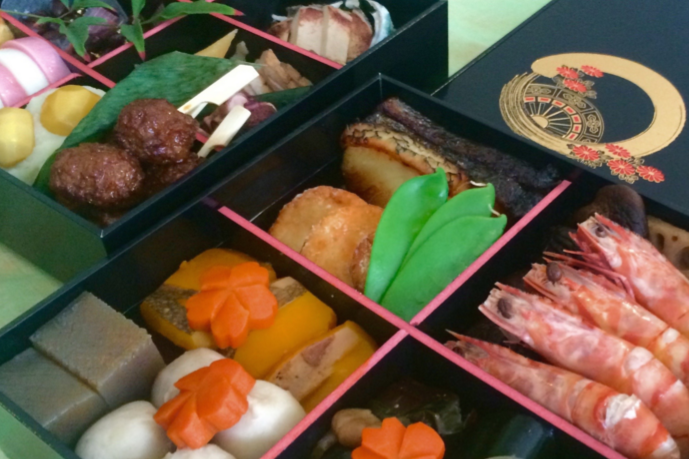
There are many New Year’s traditions in Japan, but the most delicious tradition is the eating of Osechi ryori, special food eaten to give thanks and wish for happiness and prosperity in the new year. Have you ever heard about Osechi ryori?
Osechi ryori is traditional Japanese New Year’s foods. This tradition has started since the year 800, more than a thousand years ago! This is indeed an amazing and long history. Originally, osechi ryori is made before the final of the previous year (i.e. before December 31). We normally eat this Osechi ryori during the first three days of the new year (January 1 to 3). As you know, it’s winter in Japan, until the 1960s, Japanese households didn’t typically have a fridge so Osechi Ryori needs to be able to keep at room temperature for three days. The taste of Osechi ryori foods is usually quite strong, and it’s like that to disguise any taste of the food being “old”. These days, obviously many things have changed – every home has a fridge and you can get any food needed from an abundance of convenience stores. Osechi ryori has evolved accordingly, foods no longer need super strong tastes as they can be stored better now. “Fancy” foods like lobsters and wagyu steak are used in celebrations, and every year it becomes more extravagant.
Japanese people believe this Osechi ryori makes people happy for the new year, so there will always be traditional foods included. This superstition is what has kept Japanese families cooking Osechi ryori for more than 1200 years! Osechi ryori is arguably the most important meal of the year, each dish serving as a symbol or wish for the coming year. The food is even eaten in a special way by using chopsticks that are rounded on both ends; one side for humans to use, one side for the gods.
Let’s take a look at the meanings behind some of the traditional Osechi ryori foods.
Prawns, cooked with sake and soy sauce, to make a wish for a long-life, the long beard and bent waist are symbolic of old age.
Konbu maki, wrapped in seaweed, is associated with the word ‘YOROKOBU’ meaning ‘joy’.
Kouhaku Kamaboko, slices of pink and white fish cakes, arranged in a pattern so that the colour and shapes are reminiscent of the Japanese rising sun.
Tazukuri, dried sardines cooked in soy sauce, this dish is used to wish for abundant harvests as fish were once used to fertilize rice fields.
Kuri-kinton, cooked chestnuts, used to symbolize treasures of gold and silver to wish for economic fortune in the new year.
Chikuzen -ni, simmered chicken and vegetables, cooked because the food is nutritious and keeps well at room temperature.
Datemaki, sweet omelette mixed with fish paste, eating this dish on New Year’s is a wish for scholarship and culture because it looks like a scroll.
Would you like to celebrate the beginning of a new year making wishes like the Japanese?
It takes more than 2-3 days to make Osechi ryori! So much work to do indeed. My mother took so much time to cook Osechi Ryori, but she blessed our family’s wishes. Could I do this work? Even though I love to cook, I do not think I can because of how time consuming and very difficult it is to cook it with limited ingredients.
Start new year in the Japanese way, I’m sure you’ll be filled with happiness thanks to the super magical tradition called Osechi Ryori.